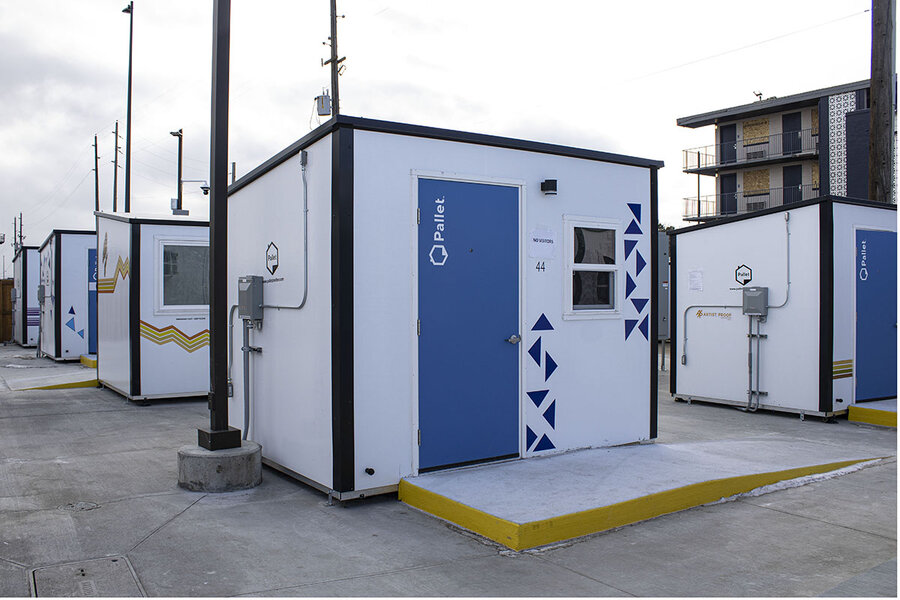Denver Mayor Mike Johnston rang in the new year checking off a resolution from 2023.
Mr. Johnston announced that his team had met a goal of moving 1,000 unsheltered people from the street indoors by Dec. 31, fulfilling a pledge from his first full day in office in July. He initiated a state of emergency on homelessness that surged city resources, spending some $45 million last year on this House1000 plan.
Why We Wrote This
A story focused on
Caring for unhoused people is a challenge many cities face. Denver recently met a goal of sheltering people, using hotels and a micro-community. The effort offers hints of progress.
Some critics contend the plan doesn’t always prioritize the most vulnerable people for shelter. The arrival of over 37,000 migrants over the past year has also strained Denver’s bandwidth. Still, supporters of House1000 see seeds of progress on tackling homelessness that other cities can consider.
“I have been really impressed with Mayor Johnston’s focus and urgency,” says Jeff Olivet, executive director of the U.S. Interagency Council on Homelessness. Sustaining this work, he adds, will mean curbing the pipeline into houselessness.
The Denver mayor’s team closed large street encampments first, sheltering most people in converted hotels and micro-community units.
After living in a Denver street tent, homeless for about six years, Christine Marie Oviedo says she’s getting used to four walls and a roof.
On the street, she says, “I was freezing to death.”
One Colorado mayor rang in the new year checking off a resolution from 2023.
Denver Mayor Mike Johnston announced that his team had moved 1,000 unsheltered people indoors by Dec. 31, fulfilling a pledge from his first days in office last year. He had initiated a state of emergency on homelessness that surged city resources, spending some $45 million last year on this House1000 plan.
Some critics contend the plan doesn’t always prioritize the most vulnerable people for shelter. The arrival of over 37,000 migrants to his city over the past year – many ineligible for work permits, at least initially – has also strained Denver’s bandwidth. Still, supporters of House1000 see seeds of progress on tackling homelessness that other cities can consider.
Why We Wrote This
A story focused on
Caring for unhoused people is a challenge many cities face. Denver recently met a goal of sheltering people, using hotels and a micro-community. The effort offers hints of progress.
“I have been really impressed with Mayor Johnston’s focus and urgency,” says Jeff Olivet, executive director of the U.S. Interagency Council on Homelessness. Sustaining this work, he adds, will mean curbing the pipeline into homelessness.
A three-pronged approach, says Mr. Olivet, should involve prevention, the scaling up of stable housing and services, and ongoing street-level crisis response for those who are unsheltered. Denver officials, meanwhile, say they’re committed to expanding House1000 in 2024.
Hotels and a micro-community
Homelessness is a persistent and growing problem in Denver as in many metro areas across the United States.
The Denver County annual point-in-time count – a one-night snapshot replicated across the country – reported 5,818 people experiencing homelessness last January. Of that group, 1,423 were unsheltered. Experts say those figures are likely less than reliable, subject to factors like inclement weather and missed “shelters’’ like hospitals and jails. The Metro Denver Homeless Initiative reports that around 28,000 people in the metro area accessed homelessness-related services between July 2021 and June 2022. A new report is expected this month.

A person collects items from a tent as Denver Parks and Recreation rangers string police tape during a city-sponsored closure of an encampment, Nov. 1, 2023, in Denver.
For House1000, the Denver mayor’s team targeted large street encampments to close first. Of around 1,150 people served so far, most were sheltered in converted hotels and micro-community units. The city says wraparound services like mental health and substance-use support are provided, along with employment assistance.
The point was to move “people to housing, rather than just sweeping them from block to block,’’ says Mr. Johnston. “We can then close those encampments and keep them closed.’’ Moving groups en masse “helped us recognize how people that are unhoused build community,” he adds. “That encampment of folks you’re living with is a real source of support.”
Denver’s efforts were partly inspired by Houston, whose encampment decommission model coordinates the entry of unsheltered people into housing.
Limited affordable housing is considered a key barrier to reducing homelessness nationwide. The Mile High City, home to some 700,000 people, isn’t an exception. By one analysis, rent in Denver rose by 82% between 2009 and 2021 – double that for the national median.
Who benefits?
Christine Marie Oviedo says she’s getting used to four walls and a roof after living in a Denver street tent, homeless for about six years.
Difficulty with securing disability benefits and a maze of casework have been barriers to stable housing, says Ms. Oviedo. In mid-December, outreach workers helped her move from an encampment into a hotel off a highway. With her bundle of blankets and clothes, she gained access to one of hundreds of units that the city has converted into transitional housing for House1000.
The hotel isn’t perfect; Ms. Oviedo, who uses a walker, says it’s hard to access the shower. But after some adjustment to her temporary room, six hours of sleep at night is now possible, she says.
On the street, she says, “I was freezing to death.”

Sarah Matusek/The Christian Science Monitor
A new micro-community for people experiencing homelessness is shown in Denver, Jan. 11, 2024. Mayor Mike Johnston plans to open more micro-communities in 2024.
Other people have moved into one of the city’s emerging micro-communities, where one-room units share communal bathrooms and laundry. Yet who gets to shelter in these spaces is a point of contention.
“All along we were telling [the mayor] we wanted to prioritize the most vulnerable people, not the most visible people,” says Terese Howard, an organizer with Housekeys Action Network Denver. She’s called for more consideration of unhoused people with severe health conditions, not just people in large encampments.
Other observers question the cost of homelessness efforts. Colorado has spent nearly $2 billion on these initiatives concentrated in metro Denver over the past three years, according to a report by the Common Sense Institute, a Colorado think tank. “Leaders should implement a new system of accountability and transparency to address the crisis,” the report concludes.
And a spokesperson for the Colorado Coalition for the Homeless calls for more information about the city’s plan to move people into long-term housing.
The initial goal, says the mayor, was to scale up transitional housing “quickly and affordably.” Now, his administration aims to add 3,000 permanent housing units this year, but their source remains unclear.
Mr. Johnston also cites the challenge of managing incoming migrants from the southern border. Without immediate access to federal work permits, many are housing-insecure.

Sarah Matusek/The Christian Science Monitor
The interior of a new micro-community for people experiencing homelessness is toured in Denver, Jan. 11, 2024.
Migrants seek shelter, too
For thousands of migrants who’ve arrived in Denver since late 2022, sometimes bused in overnight from Texas, the city has offered temporary, time-limited shelter and travel tickets elsewhere. The mayor is asking municipal agencies to find ways to trim spending, Denverite reports, to avoid the migrant response swallowing a tenth of the city’s annual general fund budget.
That’s on the mind of unhoused locals on a recent chilly afternoon downtown. Bundled in an olive-green coat, one woman waits in line to enter a homeless shelter for the night.
“We stand out here every day,” says the woman, who declined to give her name. “The migrants coming in, they get housing first. … It doesn’t make any sense.”
That morning, across town, the city began to shut down a large migrant tent encampment. Many individuals have been placed into congregate shelter and offered help with rental assistance.
Desireet Mujica, from Venezuela, regards the street of newly abandoned migrant tents beside her teenage son. Their 37 days at a migrant shelter ends early next month.
“I want to work as soon as possible,” she says in Spanish. “I don’t want my stay at the shelter to expire and not have a place to live.”
>>> Read full article>>>
Copyright for syndicated content belongs to the linked Source : The Christian Science Monitor – https://www.csmonitor.com/USA/Society/2024/0116/How-Denver-met-a-goal-to-shelter-1-000-people?icid=rss






























